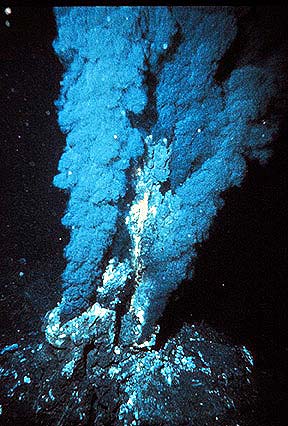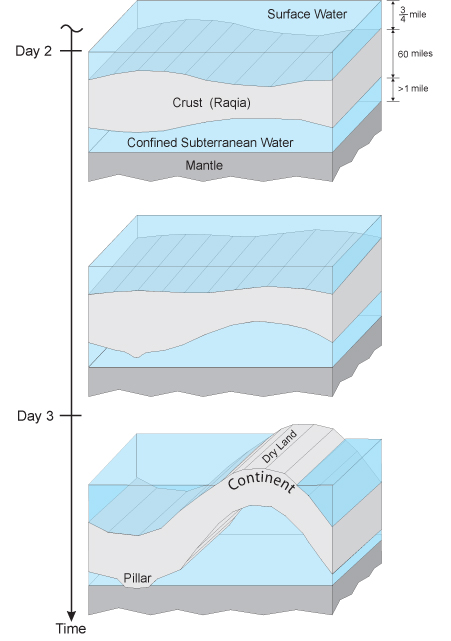Creation Corner
Creation Day 2: Firmament

On Creation Day 2, God made a “firmament among waters,” to “divide waters from waters.” Where was this? Perhaps not in space, but on earth. But what about the “firmament of the heavens” on Creation Day Four? That was a different firmament.
What is a firmament?
The Hebrew word raqia (רקיע) means a thin sheet, usually of hammered metal. This is the actual word that appears in the account of Creation Day Two (and Day Four). As a metaphor, it stands for a thin sheet that someone shapes and molds. The word firmament, in the Authorized (King James) Version, comes from the Latin word firmamentum. St. Jerome used that word to translate the Greek word stereoma that Ptolemy’s Seventy Translators substituted for the Hebrew raqia. Stereoma connotes firmness or strength. Raqia connotes flexibility and workability. And while the “firmament” of Creation Day Two might be relatively firm, people forget that God worked it to His liking.
The Genesis account mentions raqia prominently in the account of Creation Day Two (Genesis 1:6-8). It mentions that word again at Creation Day Four (Genesis 1:14-19). This time it adds the phrase “of the heavens” or “of the skies,” hence “hammered sheet of the skies” (raqia shemayim). Why add the qualifier on Day Four but not on Day Two? God has one of two reasons for the different use of the word shemayim:
- The hammered sheet is always in the sky, and He first uses that word to define something new.
- God means to describe two different hammered sheets, one on earth and one in space.
The first choice leads to an obvious problem: why does God speak of separating water from water in the sky? That implies liquid water in outer space. Astronomers have found large amounts of water surrounding far-off objects. But this would imply an unbroken wall or shell of water at the edge of the universe. Astronomers have guessed at such a thing, but no one has found it yet.
Some creation advocates, beginning with Isaac Newton Vail in 1874 and continuing with men like Carl Baugh today, believe that the expanse was a canopy that surrounded the earth’s atmosphere but was several hundreds of miles above and beyond it. Vail and others thought this canopy was filled with water; Baugh thinks it was filled with metallic hydrogen. The physical problems with such a theory are formidable alone. But more to the point, this cannot fit the description of an expanse dividing water from water.

Diagrams of the earth’s crust as the expanse or “firmament” of the earth, as it existed on Days Two and Three of creation. Figures not drawn to scale. Credit: Walter T. Brown/Center for Scientific Creation
The second choice leads to a slight confusion. Why does God say, “God called the hammered-sheet sky” (Genesis 1:8)? That depends on what He meant by the word sky (shemayim). That could mean either:
- Anything that we normally call “sky,” including where the birds fly, and the outer space beyond that, or:
- Where God lives.
Walt Brown reminds us that God did live on earth before the Fall of Man. So perhaps God meant to say, “This is where I shall live.”
Two firmaments
[ezadsense midpost]
So the Bible here describes two different firmaments, or expanses, or “hammered sheets.” One is the “expanse of the sky” that holds the sun, the moon, the stars, and all the planets. The other is on the earth, and a part of it. But what could it be? Brown gives a surprising answer: the earth’s crust.
Creation Day Two and the firmament of the earth
The Bible first mentions “the waters” in Creation Day One. Water was not the one thing that made up the earth. But water covered the earth on Day One. Then, on Day Two, the Bible describes a hammered-sheet-like expanse “in the middle of the waters” and “dividing waters from waters.”
Brown begins his description here, and continues it here. Briefly, the hammered sheet, or expanse, is the original earth’s crust. On this Day it was completely submerged, and also covered about half the water that God gave the earth. This water beneath the crust became the subcrustal ocean that would later, tragically, break out and cause a Flood. The water above the crust continued as the first surface oceans and other bodies of water.
But God was not finished with the crust, when He made it on Day Two. The Creation Day Two account does not say that “God saw that it was good.” This word good (Hebrew tov) here means “finished” and “meeting Divine approval.” So the crust was in place, but the shaping and molding would come later, during Creation Day Three.
Still, “God called the expanse heaven.” Meaning that God said that He would live there, once He finished His work.
Related:
[amazon_carousel widget_type=”ASINList” width=”500″ height=”250″ title=”” market_place=”US” shuffle_products=”True” show_border=”False” asin=”0890512760, 1878026097, 0875523382, 0743290313, 0890514119, 0890514410, 0932766412, 0061472794, 0895262002, 0685459039″ /]
[ezadsense leadout]
Terry A. Hurlbut has been a student of politics, philosophy, and science for more than 35 years. He is a graduate of Yale College and has served as a physician-level laboratory administrator in a 250-bed community hospital. He also is a serious student of the Bible, is conversant in its two primary original languages, and has followed the creation-science movement closely since 1993.
-

 Civilization1 day ago
Civilization1 day agoDC Pipe Bomb Arrest Raises Questions About Christopher’s Wray’s FBI
-

 Executive4 days ago
Executive4 days agoThe Last Supper: New York’s Socialist Feast
-

 Civilization4 days ago
Civilization4 days agoYoo Hoo, VP Vance—Your Character is Showing!
-

 Guest Columns3 days ago
Guest Columns3 days agoCongressional Leaders See Far Higher Stock Returns Than Peers
-

 Civilization2 days ago
Civilization2 days agoThe Legal Logic Behind U.S. Operations Against Narco-Terrorist Networks
-

 Civilization4 days ago
Civilization4 days agoFacing Facts & Rolling Back Mythologies: The New National Security Strategy
-

 Civilization3 days ago
Civilization3 days agoHow Trump Changed America
-

 Civilization5 days ago
Civilization5 days agoWaste of the Day: Senators Earmarked Cash for Their Former Schools















So far so good! Excellent little series you got going here. These articles will make for nice handouts, especially with the nice imagery to illustrate.
God Bless
Be sure to give credit to Dr. Walt Brown! (That’s his graphic, by the way.) And to any other person whose theories I happen to quote.
Terry, I have a serious question and hopefully you’ll see fit to publish it and provide a considered answer.
Now the premise behind YEC is that God created everything in 7 days. Now, I find it strange that creation scientists feel the need to come up with all sorts of convoluted theories to explain away events that happened in the Bible. (It’s much like Andrew Schlafly reducing Jesus’ miracles to quantum events).
By assigning a natural cause to the flood, aren’t you removing God from the equation? According to the hydroplate theory, God had nothing to do with it, and Noah was lucky enough to read the signs and build a boat. Surely if God, who did after all create the universe in 7 days, wanted to wipe out mankind, He could summon the rain to fall and cause the flood?
Why the need to explain away God from what happened?
You’re getting way ahead of yourself. (You’re also misconstruing Mr. Schlafly’s own commentaries, but that’s a bit off-topic here.) If you will recall, I specifically said that an unrecorded act of man set in motion the chain of events that caused the crust to fail. I also promised to address that later. But you couldn’t wait.
But in the process you fall into another trap: asking a creation advocate to do that for which your side routinely criticizes creation advocates. Evolution advocates criticize creation advocates, in many other contexts, for appealing to miracles whenever they can’t explain something. (I’ve had one person insist that if I cannot explain, naturally, the origin of life, I have no argument!) Now here you criticize me for not appealing to miracles! To paraphrase Herman (The Caine Mutiny) Wouk, I respectfully suggest that you make up your mind which policy you prefer!
The cause (and by that I mean trigger) of the Global Flood is sin. I haven’t even discussed the trigger—yet. And I won’t do it in this comment space. That is, to paraphrase any high-school mathematics textbook that touches on an advanced concept, “beyond scope.” In another article I shall bring it within scope.
The process of the Global Flood is still natural. As such, it has consequences, Predictable consequences, which other investigators have seen, though they won’t admit that the process existed, much less what part of the process led to what they’ve seen. By working out that process, with the brutal economy of miracles that Brown prefers, Brown explains much, much more to which the Bible attests. Many of these things seem incredible, like a human lifespan averaging nine hundred years, that declines by ninety percent in twelve generations. (See Genesis chapter 11.) And many other things, like geothermal heat, too many people try to suggest preceded the Flood, because they’re still clinging to theories like solar nebulae and planet-scale accretion. He also can explain many facts about the world we observe around us. All this answers the question, “If the whole world flooded, where is the silt? Where did the water go? Where is your evidence?”
I started this reply by mentioning those who criticize creation advocates for invoking miracles too often. “‘Goddidit’ is not an answer,” they sneer. Well, sometimes it has to be—like, for example, the creation of life. At other times, it’s worth asking, “If that was a miracle, why doesn’t the Bible attest to it?” Or, “What does the Bible mean by such-and-such?”
Furthermore, Walt Brown takes the position, and it’s a position I happen to share, that too many creation advocates do invoke miracles unnecessarily. He has proposed what I would call an Occam’s Razor for miracles—or, if you like, Brown’s Razor. It reads: Don’t multiply miracles without sufficient grounds. The simplest explanation, even the most natural explanation, that fits the Biblical Record and all observable facts is the preferable one.
Now to address some of the details you mentioned: The Hydroplate Theory says that the crust failed and released a subcrustal ocean. It even suggests part of the reason for the failure. But Brown does not discuss things that Noah might have recognized. On the other hand, Noah directly attests (Genesis 6:2) that God gave him 120 years’ advance warning. Noah’s sons (Genesis 6:9b-10:1a, the Annals of Shem, Ham and Japheth) give the greater details of that warning (though it’s only about the character of man) and the basic design elements of a great life ship (Hebrew tvah) that would carry eight people, and specimens of all the land and flying animals then extant, and see them through the cataclysm to come. Prophecy is a miracle, and the Bible carefully records each prophecy and, where applicable, its fulfillment.
Thank you for your reply. However, please do not lump me in with with people asking for goddidit responses and things like “your side.” That kind of mindless antagonism is unfounded and unwarranted, especially as you do not know me, not do you know my personal beliefs. But be that as it may.
Now, unfortunately, I must reject the rest of what you said out of hand. To use your own words back at you “make up your mind which policy you prefer”. By attributing a natural cause to the Flood – which you are – you remove God from the equation. You cannot on one hand claim He effortlessly created the universe and on the other say He had to resort to a massively complex mechanism to wipe out a small race of beings. It is illogical and nonsensical.
I also reject Brown’s “brutal economy of miracles” which serves to remove God from most of the Creation process, in essence reducing Him to a form of Big Bang, from whence everything else originated. It is a form of apostasy that I find very distasteful. You complain that science denies God – from what I read here, Brown – and by supporting him, yourself – are doing exactly the same.
I shall pray for you.
That’s a matter of opinion. On the other hand, you’ve lost sight of certain things that are clearly miraculous. Like the meticulous planning that went in to the formation of the earth’s crust, so that (as you’ll see in the next article) it would settle in some places, and bulge up in others, and in exactly the right spots. And I haven’t even mentioned—yet—the first planting. That’s coming up. That’s one miracle among many that I won’t give up.
[…] Creation Day 2: Firmament […]
[…] Creation Day 2: The Firmament […]
“this would imply an unbroken wall or shell of water at the edge of the universe. Astronomers have guessed at such a thing”
No they haven’t.
[…] Creation Day 2: Firmament […]
[…] Isaac Vail, in 1874, first suggested such a canopy. He read the account of Creation Day Two, about the “expanse in the middle of the waters.” But he completely misread that. That […]
[…] Reprinted from Conservative News and Views. […]